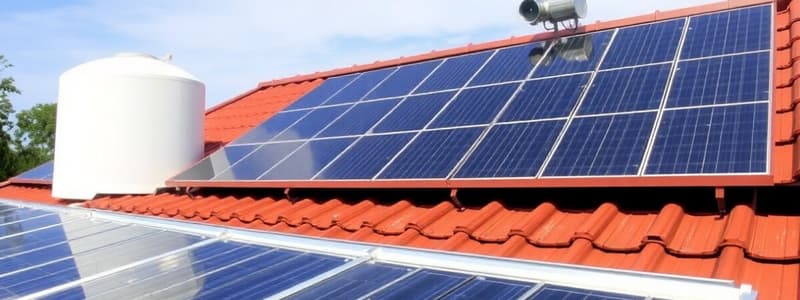Podcast
Questions and Answers
What does PWM stand for in the context of charge controllers?
What does PWM stand for in the context of charge controllers?
- Parallel Wiring Method
- Pulse Width Modulation (correct)
- Peak Wattage Maximizer
- Power Wave Management
What does FLA stand for in the context of batteries?
What does FLA stand for in the context of batteries?
- Flooded Lead Acid (correct)
- Flexible Load Adapter
- Fast Load Alternator
- Fixed Lithium Array
What is one of the conditions defined by Standard Test Conditions (STC)?
What is one of the conditions defined by Standard Test Conditions (STC)?
- Uncontrolled atmospheric pressure
- Fluctuating humidity levels
- Variable wind speed
- Specific cell temperature (correct)
Which system uses sun-tracking mirrors?
Which system uses sun-tracking mirrors?
In a direct active solar water heating system, what is directly heated?
In a direct active solar water heating system, what is directly heated?
In an indirect active solar water heating system, what is heated by the sun?
In an indirect active solar water heating system, what is heated by the sun?
What is the primary function of charge controllers in a solar power system?
What is the primary function of charge controllers in a solar power system?
What do peak sun hours measure?
What do peak sun hours measure?
Which of the following is a general disadvantage of solar PV/thermal systems?
Which of the following is a general disadvantage of solar PV/thermal systems?
Which type of solar battery is known for requiring regular maintenance?
Which type of solar battery is known for requiring regular maintenance?
What is a characteristic of grid-connected systems?
What is a characteristic of grid-connected systems?
Which of the following is a basic type of PV cell?
Which of the following is a basic type of PV cell?
What is the purpose of sun-tracking mirrors in power tower systems?
What is the purpose of sun-tracking mirrors in power tower systems?
Why are grid-connected systems tied to the utility grid?
Why are grid-connected systems tied to the utility grid?
What is the primary function of solar thermal systems?
What is the primary function of solar thermal systems?
What distinguishes solar PV systems from solar thermal systems?
What distinguishes solar PV systems from solar thermal systems?
Which of the following is a low-temperature application of solar thermal energy?
Which of the following is a low-temperature application of solar thermal energy?
What is a typical use for medium temperature solar thermal applications?
What is a typical use for medium temperature solar thermal applications?
Which of these is an example of a high-temperature application of solar thermal energy?
Which of these is an example of a high-temperature application of solar thermal energy?
What is the shape of the solar concentrators used in parabolic trough systems?
What is the shape of the solar concentrators used in parabolic trough systems?
What do parabolic dish systems primarily focus solar energy on?
What do parabolic dish systems primarily focus solar energy on?
What is special about parabolic dish systems?
What is special about parabolic dish systems?
What is doping in the context of solar panels?
What is doping in the context of solar panels?
What is a solar panel called when it's built into a structure?
What is a solar panel called when it's built into a structure?
What is the primary function of inverters in a solar power system?
What is the primary function of inverters in a solar power system?
What do batteries primarily store in a solar power system?
What do batteries primarily store in a solar power system?
In what unit is battery capacity typically measured?
In what unit is battery capacity typically measured?
Under what temperature conditions do PV panels generally produce more voltage?
Under what temperature conditions do PV panels generally produce more voltage?
Which component is NOT part of a battery-powered standalone system?
Which component is NOT part of a battery-powered standalone system?
Which of these PV systems uses lenses or mirrors to focus sunlight onto a receiver?
Which of these PV systems uses lenses or mirrors to focus sunlight onto a receiver?
Flashcards
Solar Thermal Systems
Solar Thermal Systems
Systems that convert solar energy into thermal energy for heating applications.
Solar PV System
Solar PV System
Systems that convert sunlight directly into electricity using photovoltaic cells.
Low Temperature Applications
Low Temperature Applications
Uses of solar thermal systems for heating below 100°C (e.g., water heating).
Medium Temperature Applications
Medium Temperature Applications
Signup and view all the flashcards
High Temperature Applications
High Temperature Applications
Signup and view all the flashcards
Parabolic Trough Applications
Parabolic Trough Applications
Signup and view all the flashcards
Parabolic Dish Systems
Parabolic Dish Systems
Signup and view all the flashcards
Utility-Scale Solar Thermal Systems
Utility-Scale Solar Thermal Systems
Signup and view all the flashcards
Charge Controllers
Charge Controllers
Signup and view all the flashcards
PWM Charge Controller
PWM Charge Controller
Signup and view all the flashcards
MPPT Charge Controller
MPPT Charge Controller
Signup and view all the flashcards
FLA Batteries
FLA Batteries
Signup and view all the flashcards
AGM Batteries
AGM Batteries
Signup and view all the flashcards
Direct Solar Water Heating System
Direct Solar Water Heating System
Signup and view all the flashcards
Indirect Solar Water Heating System
Indirect Solar Water Heating System
Signup and view all the flashcards
Disadvantages of Solar PV/Thermal Systems
Disadvantages of Solar PV/Thermal Systems
Signup and view all the flashcards
Doping
Doping
Signup and view all the flashcards
Inverter
Inverter
Signup and view all the flashcards
Battery Storage
Battery Storage
Signup and view all the flashcards
Watt-hour
Watt-hour
Signup and view all the flashcards
PV Panels Voltage
PV Panels Voltage
Signup and view all the flashcards
Concentrating Collector
Concentrating Collector
Signup and view all the flashcards
Flat Plate Collector
Flat Plate Collector
Signup and view all the flashcards
Monocrystalline PV
Monocrystalline PV
Signup and view all the flashcards
Standard Test Conditions (STC)
Standard Test Conditions (STC)
Signup and view all the flashcards
Types of PV cells
Types of PV cells
Signup and view all the flashcards
Power Tower systems
Power Tower systems
Signup and view all the flashcards
Grid-connected systems
Grid-connected systems
Signup and view all the flashcards
Peak sun hours
Peak sun hours
Signup and view all the flashcards
Insolation
Insolation
Signup and view all the flashcards
Study Notes
Solar Thermal Systems vs. Solar PV Systems
- Solar thermal systems use the sun's energy to heat water or other fluids.
- Solar PV systems use the sun's energy to generate electricity.
Solar Thermal Applications
- Low Temperature Applications: Heating water for domestic use, swimming pools, etc.
- Medium Temperature Applications: Space heating, industrial processes requiring lower temperatures.
- High Temperature Applications: Concentrating solar power plants, industrial processes needing high temperatures.
Types of Utility-Scale Solar Thermal Systems
- Parabolic trough applications: Use parabolic mirrors to concentrate sunlight onto a receiver.
- Parabolic dish systems: Use a dish-shaped reflector to concentrate sunlight onto a receiver.
- Power Tower System: Uses a large field of mirrors to concentrate sunlight onto a receiver.
Charge Controllers
- PWM (Pulse Width Modulation)
- MPPT (Maximum Power Point Tracking)
Types of Solar Batteries
- FLA (Flooded Lead-Acid) Batteries
- AGM (Absorbent Glass Mat) Batteries
Types of Active Solar Water Heating Systems
- Direct: Water flows directly through the solar collector.
- Indirect: Water flows through a heat exchanger connected to the solar collector.
Solar PV/Thermal System Disadvantages
- (Information not provided)
Standard Test Conditions (STC)
- (Information not provided)
Types of PV Cells
- (Information not provided)
Power Tower System Description
- Solar power towers use a system of sun-tracking mirrors to concentrate sunlight.
Grid-Connected Systems
- Grid-connected systems operate in parallel with the utility grid, and are tied to it.
Charge Controllers Usage
- Charge controllers are used to maximize the efficiency of solar energy collection.
Peak Sun Hours or Insolation
- (Information not provided)
Doping Process
- (Information not provided)
Solar Panel Structure
- When built into a structure, a solar panel is sometimes referred to as a solar roof.
Battery Storage Capacity
- Measured in watt-hours.
Solar Panel Installation Locations
- Not limited to hot, sunny locations though these areas are optimal for best performance.
Battery Voltage and Temperature
- Efficiency of solar panels and battery storage varies with temperature, not just heat.
Flat Plate Collector
- A type of solar thermal collector.
Evacuated Tube Collector
- A type of solar thermal collector.
Passive and Active Solar Water Heaters
- (Information not provided)
Parabolic Trough System
- (Information not provided)
Power Tower System
- (Information not provided)
Polycrystalline PV, Monocrystalline PV
- (Information not provided)
Thermosiphon System
- (Information not provided)
MPPT Charge Controller
- (Information not provided)
Parabolic Dish
- (Information not provided)
Basic Types of PV Systems
- (Information not provided)
Grid-Interactive PV System Components
- (Information not provided)
Abbreviations
- BIPV (Building-Integrated Photovoltaics)
- DOD (Depth of Discharge)
- MPPT (Maximum Power Point Tracking)
- PWM (Pulse Width Modulation)
- BOS (Balance of System)
Studying That Suits You
Use AI to generate personalized quizzes and flashcards to suit your learning preferences.



